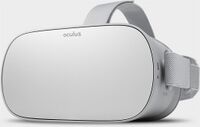Oculus Go (oculus-pacific): Difference between revisions
WolfLink115 (talk | contribs) m Updated build status and fixed minor things. |
WolfLink115 (talk | contribs) mNo edit summary |
||
| Line 5: | Line 5: | ||
{{Infobox device | {{Infobox device | ||
| manufacturer = Oculus | | manufacturer = Oculus | ||
| name = (Oculus Pacific) | | name = Go (Oculus Pacific) | ||
| codename = oculus-pacific | | codename = oculus-pacific | ||
| image = File:QuestGo.jpg | | image = File:QuestGo.jpg | ||
Revision as of 09:13, 21 December 2022
| This device is a VR Headset. The display may not look how it should. |
| This pmOS port is currently a WIP. Updates on working hardware will appear on this page as they come in. This port is not using Mainline, however a mainline build is planned. |
It is currently able to boot Mainline (very very minimal). Only display is seemingly working. Currently not possible to figure out what else at the moment since you cannot really see what is happening on the screen, since it is all past the viewing FOV.
 Oculus Go | |
| Manufacturer | Oculus |
|---|---|
| Name | Go (Oculus Pacific) |
| Codename | oculus-pacific |
| Released | 2018 |
| Hardware | |
| Chipset | Qualcomm Snapdragon 821 |
| CPU | 2x 2.2/2.3 GHz Kryo, 2x 1.6 GHz Kryo |
| GPU | Adreno 530 |
| Display | 2560x1440 (538 ppi) (1280×1440 per eye) |
| Storage | 32, 64 GB |
| Memory | 3 GB |
| Architecture | aarch64 |
| Software | |
| Original software | Android 7.0.1 |
| postmarketOS | |
| Category | testing |
| Pre-built images | no |
| Mainline | partial |
| Flashing |
No data |
|---|---|
| USB Networking |
No data |
| Internal storage |
No data |
| SD card |
No data |
| Battery |
No data |
| Screen |
Works |
| Multimedia | |
| 3D Acceleration |
Broken |
| Audio |
No data |
| Camera Flash |
No data |
| Connectivity | |
| WiFi |
No data |
| Bluetooth |
No data |
| GPS |
No data |
| NFC |
No data |
| Miscellaneous | |
| FDE |
Broken |
| USB OTG |
No data |
| HDMI/DP |
No data |
| Sensors | |
| Accelerometer |
Broken |
| Magnetometer |
No data |
| Ambient Light |
No data |
| Proximity |
No data |
| Hall Effect |
No data |
| Haptics |
No data |
| Barometer |
No data |
| This device is based on the Snapdragon 821. See the SoC page for common tips, guides and troubleshooting steps |
Special Boot Modes
Fastboot Mode
While in Fastboot mode, you can use + to select an action from the menu at the top of the screen, and to select the action (i.e. Exit and boot the device, Factory reset, Enable sideloading update, and Power off.)
You can also use a computer to issue Fastboot commands to flash firmware to the device and manage the current slot that the bootloader is using to boot the operating system.
Enter Fastboot Mode
Just hold down + for a few seconds to enter Fastboot mode.
Unlock the bootloader
To unlock the bootloader you must have access to a PC and the Oculus USB drivers.
- First download the drivers if you have not done so already: Oculus ADB drivers.
- Second go to the Oculus Go's bootloader unlock site and download the update package: Official unlock website. It also has the instructions to unlock the bootloader.
- Once you have those boot into the bootloader and navigate to the "Enable Sideload Update" option using the and/or keys and press
- When the sideload prompt comes up use ADB to sideload the unlocked_build.zip OTA to your headset. When it is finished navigate to "Reboot system now" and select it if the headset didn't automatically reboot for you.
- Once the headset boots into the OS, reboot to bootloader again and type
fastboot oem unlock
on your PC. Read the message displayed on your device screen, if you agree then confirm the unlock. THIS WILL ERASE YOUR DEVICE.
Maintainers
Users owning this device